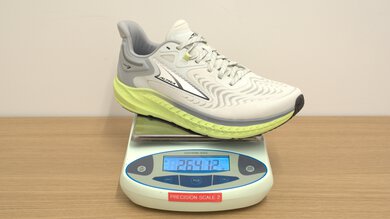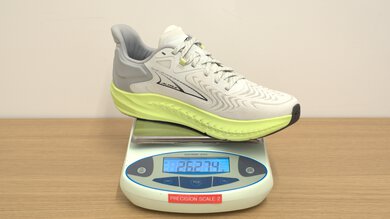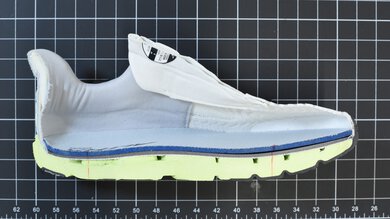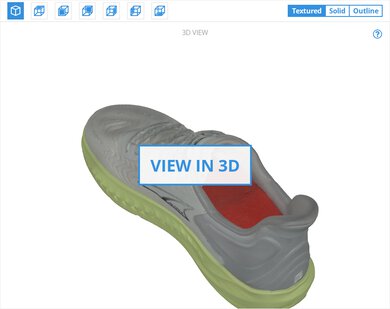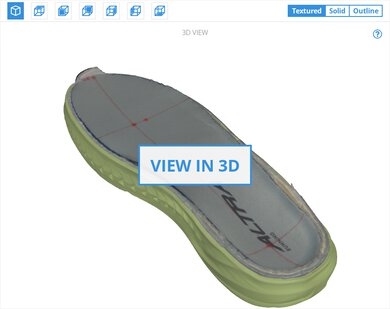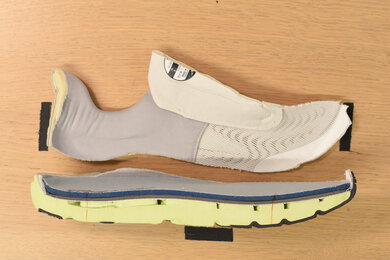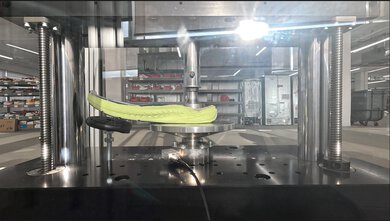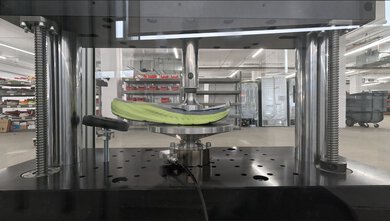The Altra Torin 7 is a versatile zero-drop daily trainer with a wide toe box. The midsole foam features an EVA and TPU blend. With a gentle forefoot rocker and moderate stack height, this shoe is designed to suit a wide range of workouts, though it doesn't particularly excel in any specific area. While not the lightest option available, it delivers reliable stability and comfort, making it a good choice for runners transitioning to or already preferring zero-drop footwear.
Our Verdict
The Altra Torin 7 falls short as a marathon racing shoe. The shoe is noticeably heavier than ideal race-day options. Its midsole lacks the energetic rebound expected from high-performance marathon shoes, leading to a ride that feels flat. While it offers some level of cushioning, it doesn't stand out in terms of softness or impact protection, which could lead to fatigue over long distances. One area where the shoe does perform relatively well is stability, which helps with control but does little to offset its lack of dynamism.
-
Very stable and secure.
-
Wide outsole makes for a stable platform.
-
Quite heavy.
-
Cushioning is insufficient.
-
Flat and muted experience.
The Altra Torin 7 delivers a mixed experience for 5K and 10K racing, offering some structural advantages but falling short in key performance areas. Its forefoot foam firmness stands out as a strength, providing a solid and supportive platform that can aid in toe-off efficiency. However, the shoe is heavier than ideal racing models, which can slow down turnover and reduce overall speed potential. While it may offer a stable and consistent ride, it lacks the lightness, snug fit, and rebound that define a strong racing flat.
-
Firm midsole foam.
-
Quite heavy.
-
Flat and muted experience.
The Altra Torin 7 has poor energy return, meaning you won't get a bouncy feel from this shoe. The underfoot feel is muted, as it's not very responsive.
-
Flat and muted experience.
-
Dull midsole.
The Altra Torin 7 falls short in cushioning, offering a level of underfoot protection that feels underwhelming for runners seeking comfort and impact absorption. Both the heel and forefoot cushioning fail to provide the plushness needed for a truly protective ride, making longer runs feel less forgiving.
-
Cushioning is insufficient.
The Altra Torin 7 offers very good lateral stability, providing a secure ride that helps runners maintain control. Its wide outsole arch and firm heel structure create a stable platform, reducing lateral movement and promoting efficiency. The combination of forefoot and heel foam firmness further enhances support, ensuring a steady feel throughout the stride. While it lacks a gusseted tongue, its overall design delivers strong stability.
-
Very stable and secure.
-
Firm midsole foam.
-
Wide outsole makes for a stable platform.
-
Non-gusseted tongue.
- 4.6 Marathon Racing
- 6.1 5K/10K Racing
Performance Usages
- 3.2 Energy Return
- 5.7 Cushioning
- 7.9 Lateral Stability
Changelog
- Updated Apr 02, 2025: Converted to Test Bench 0.8.
- Updated Apr 02, 2025: Review published.
Differences Between Sizes And Variants
We tested the Altra Torin 7 in men's US size 9 in the Gray/Green colorway, as indicated on the label. This model is available in a full range of sizes for both men and women, with wide versions offered separately for each, and it comes in a variety of colors depending on your region, including White/Blue, Dark Gray, Orange, Gray/Red, Gray/Orange, Deep Teal/Pink, and White/Black. The design section applies only to the exact model we tested, but we expect other size and gender variants to perform similarly.
Compared To Other Running Shoes
Like all Altra shoes, the Torin 7 has a zero heel-to-toe drop, keeping the foot level with the ground. It also has a wider toe box than most shoes, intended to give the toes more room to splay out.
While the cushioning is relatively poor compared to many max-stack shoes like the HOKA Mach X 2, the Altra Torin 7 still offers some protection, making it a more forgiving option than the Altra Escalante 4 or other zero-drop shoes that venture into the barefoot category. It's not as close to the ground, giving it a bit more versatility for those who want a balance between ground feel and impact absorption.
However, for most runners, a modern trainer with a moderate drop, like the ASICS NOVABLAST 5, may be a better option, as the Torin 7's design prioritizes stability at the expense of other performance factors like cushioning and energy return.
For more options, check out our recommendations for the best running shoes.
The Altra Torin 7 and the Nike Pegasus 41 are both daily trainers offering comparable levels of stability. The Torin 7 features a zero-drop design and some cushioning, appealing to those who prefer a more grounded feel and a wider toe box. However, its cushioning, while present, may not provide the plushness some runners desire. In contrast, the Pegasus 41 maintains a traditional higher heel-to-toe drop, which can benefit heel strikers looking for a smooth transition. Also, the Nike has a slightly more energetic ride. This makes the Nike a suitable option for runners who prefer to avoid max-cushioned models but still desire a higher heel-to-toe drop.
The Altra Torin 7 and the ASICS GEL-KAYANO 31 are both daily trainers emphasizing stability, catering to runners seeking support during their runs. The GEL-KAYANO 31 offers even higher stability, featuring a wider base at the arch. However, this comes with added weight, making the GEL-KAYANO 31 heavier than the Torin 7. Another key difference is the heel-to-toe drop: the ASICS features a high drop, whereas the Altra offers a zero-drop platform.
The Altra Torin 7 and the Brooks Glycerin Max are both reliable daily trainers designed for runners who prioritize consistency over energy return. The Glycerin Max offers a plush, max-cushioned experience with its substantial stack height ideal for long runs and recovery days. In contrast, the Torin 7 emphasizes stability through its lower stack height and zero-drop platform, promoting a natural foot strike.
Test Results
The heel energy return of this shoe is noticeably lacking, making it feel dull and unresponsive upon impact. When landing on the heel, the foam compresses but does not effectively rebound, causing a loss of momentum rather than propelling the runner forward. This results in a muted ride, particularly for heel strikers who rely on energy return to transition smoothly through their stride.
The forefoot energy return is better than the heel energy return but still poor. This shoe simply lacks the dynamism found in more performance-oriented shoes, especially during faster efforts or when trying to pick up the pace.
The Altra Torin 7 has a disappointing amount of cushioning at the heel, providing minimal shock absorption. This can still suit runners who appreciate some protection at heel strike but don't require a deeply cushioned ride. However, those seeking a more pillowy landing may find it inadequate.
The forefoot is slightly more cushioned than the heel, as expected. However, the level of energy absorbed is still sub-par, as it doesn't deliver the highly cushioned sensation found in max-cushioned trainers like the HOKA Mach X 2. Therefore, it may not satisfy those seeking a very padded underfoot experience.
The Altra Torin 7 has a remarkably firm heel. This high level of firmness plays a key role in enhancing the shoe's overall stability, making it a solid choice for runners who prioritize a secure and supportive ride. However, those who prefer a softer heel may find it too rigid.
The forefoot of this shoe is extremely firm, contributing significantly to the shoe's overall structure and stability. This rigidity ensures a stable platform for toe-offs, which can benefit runners looking for a more controlled ride. However, it may feel too firm for those who prefer a softer forefoot.
Comments
Altra Torin 7: Main Discussion
Let us know why you want us to review the product here, or encourage others to vote for this product.


